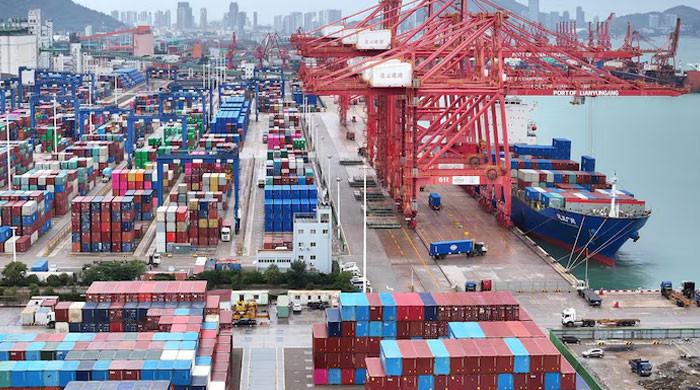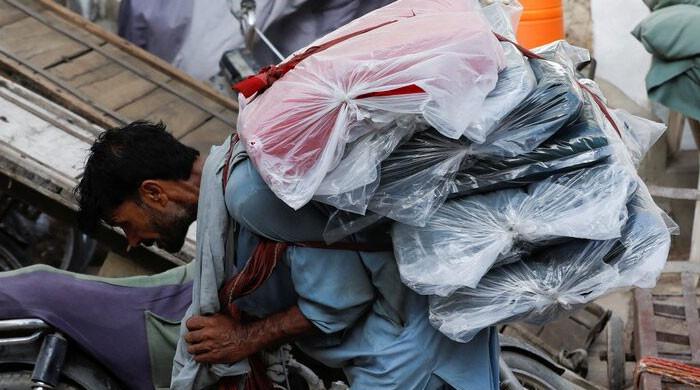Large-scale manufacturing sector weighed down by 5.5% in Nov 2022
Pakistan’s GDP could also suffer as this sector contributes nearly a fifth to the economy with declining industrial output
January 18, 2023

- Affected sectors include textiles, food, garments and more.
- From July-Nov 2022, average output contracted by 3.58%.
- World Bank projects GDP growth rate at 2% for FY23.
ISLAMABAD: Large-scale manufacturing (LSM) output declined by 5.5% in November 2022 as compared to the same month a year ago due to the government's policy for controlling inflation, dollar scarcity, and import curbs, The News reported Wednesday.
As per the data released by the Pakistan Bureau of Statistics (PBS), the affected sectors include textiles, food, garments, chemicals, automobile, cement, and fertilisers.
The output went up by 3.55% in the previous month in October 2022. Meanwhile, in five months from July to November 2022, the average output contracted by 3.58% over the same period last year.
The government’s policy for curbing inflation with interest rate increases and "quantitative tightening", has made bank financing expensive. Besides, the dearth of dollars and the government’s strict policies for limiting imports have been hard-hitting for the industrial sector. Over the last few months, factories have reduced their operating days/hours, and especially since last month, some have reported the closure of their units on inventory shortages due to the non-availability of foreign exchange to import raw materials.
With the declining industrial output, Pakistan’s gross domestic product (GDP) could also suffer as this sector contributes nearly a fifth to the economy. The federal government has also hinted that the growth could be near 3% against the target of 5%.
The World Bank in its latest “Global Economic Prospects report,” has projected Pakistan’s GDP growth rate at 2% for FY23.
Earlier, the Asian Development Bank (ADB) also projected GDP growth at 3.5% in FY23 mainly due to quantitative tightening including limiting fiscal spending to control fiscal and external imbalances.
A contraction in demand, together with capacity and input constraints created by higher import prices from the rupee’s depreciation, would reduce industry output.
The government in the federal budget 2022-23 in June had targeted to grow the economy by 5%.
July 2022 was the first month in nearly two years when LSM growth nosedived, with LSM output contracting by 16.5% over June 2022 and 1.4% over July 2021.
The PBS’s latest monthly bulletin on LSM showed the majority of the sectors with negative growth in November 2022. Interestingly, out of 25 industrial categories covered under LSM data, only five showed positive growth that includes garments, leather products, furniture, football, beverages, coke and petroleum products.
However, the output of sectors having high weightage in the Quantum Index Number of LSM contracted. These were textile, food, iron and steel, chemicals, automobile, pharmaceuticals, cement, and non-metallic mineral products.
On a year-on-year basis, in November 2022, textiles output was down 22%, pharmaceuticals 8.34%, non-metallic minerals 13%, food 13.6%, iron and steel 8.7%, chemicals 7.06% (of which chemical products output was down 6.15% and fertiliser 7.74%) and cement output also dipped 12.1% over the same month last year.
Similarly, machinery and equipment output also declined by 56%, automobiles by 18.97%, fabricated metals by 18.4%, rubber products by 9.3%; computer, electronics, and optical products by 29.8%; wood products by 80.5%, tobacco by 20.25%, paper and board 1.7% and other transport equipment output went down by 41% over November 2021.
A few sectors that showed positive growth included garments up 49.7%, leather products 9.84%, furniture 36.4%, footballs 55.6%, beverages 9.97%, and coke and petroleum products up 5.26%.
Output during July-November FY23 as compared to the same period of FY22 has increased only in wearing apparel (garments) by 51.48%, leather by 9.84%, furniture by 99.3%, and footballs by 59.7%.
Whereas, food output declined by 7.78%, beverages by 5.4%, tobacco by 22.3%, textiles by 11.45%, wood products by 63.6%, paper and board by 2.8%, coke and petroleum products by 13.6%, pharmaceuticals by 23.2%, rubber products by 9%, non-metallic mineral products by 12.35%, computer, electronics, and optical products by 17.17%, machinery and equipment by 41.2%, and automobiles by 28.7%. Besides, the output of fabricated metal was down by 18.23%, iron and steel by 0.87%, and other transport equipment declined by by 42% over the same period of last year.











